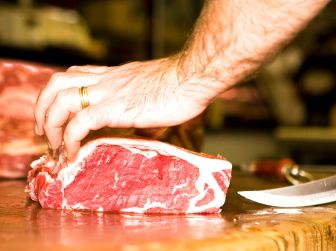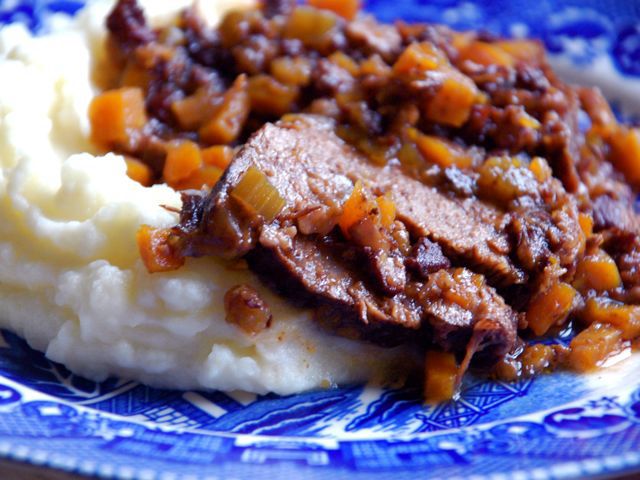
reference-image, l
(article, Kelly Myers)
[%pageBreakSettings nobreak=true] You’ve heard the call before, ringing louder these days with rising food costs: We need to move meat away from the center of our all-American diet. We all need to eat less meat, less often. [[block(sidebar). h1.Featured recipes]] But then you think of Sunday breakfast, of pancakes dripping maple syrup and strips of crispy, fatty bacon. “If I cut back on meat,” you fret, “will breakfast, lunch, and dinner still be appealing?” Not to worry. It is this cook’s opinion that we need to know more about cooking meat in order to eat less of it. Here’s how to enjoy your meat and save money, too. h3. Buy the whole animal — or just act as if you did As a chef, I’ve found that the best tips for cooking with less protein come from cuisines that utilize the whole animal. These cuisines know how to get more meaty flavor from less animal. Imagine that you have purchased a steer. Every time you approach the meat counter, choose a cut as if that steer now sits in your freezer all packaged up, and you are deciding which piece to thaw and eat. First, widen your field of vision beyond the commonly consumed roasts and steaks — flank, strip, skirt, and the like. These are tender and cook relatively quickly, but they’re not cheap. It doesn’t make sense to buy them on a regular basis. [%image reference-image float=left width=400 caption="Don't choose only the most commonly consumed cuts of beef."] After all, each head of cattle has a finite number of steaks and roasts, and a meal built around either demands a lot of meat on each plate. So designate prime rib, porterhouse steaks, and tenderloin for special occasions. That leaves quite a few parts of the steer that, while delicious, are tougher and can’t simply be cooked rare to medium rare like steaks or roasts. Much of this tougher meat is sold already ground, or as cuts suitable for braising: brisket, chuck roast, short ribs, and the round. (At Mexican and Asian markets, you will see cheeks, feet, oxtails, shanks, ears, tripe, snouts, and more. If all this is new to you, consider those your advanced lesson in meat economy.) h3. Get your braise on for deep flavors and multiple meals When you braise, you get falling-off-the-bone meat as well as rich braising liquid, both easy components of two or three dinners. Braising cuts are almost always affordable, but they require long, slow cooking to tenderize the muscle and soften their connective tissue. This isn’t a bad thing. A couple of hours at the merest of simmers (never, ever a boil) coaxes out flavor without drying the meat. In fact, the meat should be succulent. The connective tissue melts into gelatin, subtly thickening the broth and giving it a gloss. I like braising because it easily puts food on the table. Make a big pot of lamb stew with rosemary and olives, for example, a day or two ahead of when you plan to serve it. This allows the meat to relax and reabsorb the cooking liquid, keeping it moist. [%image braise float=right width=400 caption="When you braise you get falling-off-the-bone meat, as well as the rich braising liquid."] The first night, enjoy the stew over polenta with a glass of wine, a green salad, and friends. Have fruit for dessert. The next day, break apart the chunks of meat into shreds and thin the stew with a little broth for a pasta sauce. Freeze any remaining pasta sauce for later. h3. Use meat as a flavor base Not feeling up to braising a large hunk of meat, either because of time or wallet considerations? Buy a smaller amount of cheaper, fattier meat, and use it as flavoring. Now’s the time to appreciate the glory — and the utility — of pork. Sauté just a couple of ounces of pancetta or bacon (both are cured pork belly; bacon is usually smoked) to a rich golden color with mirepoix (a mince of carrots, celery, and onion), and you’re nearly guaranteed a well-rounded soup. Do the same to a few chunks of good-quality bulk pork sausage, and you’ll have meaty flavor and texture in pasta sauces. Or follow in the footsteps of my mom, who makes white beans and escarole with bulk pork sausage for dinner; you can make something similar by using White Bean, Dried Bread, and Escarole Soup as a base. h3. Use meat outside the main course Hit up a good deli for charcuterie like terrines, cured ham, or pâtés; serve these in small amounts (they’re fatty and will fill you up fast) on toast or crackers as a first course. Or serve an appetizer of chicken livers chopped with capers and sage on bruschetta, and round out the meal with a big salad or tureen of soup. Don’t feel like an appetizer course? Add bits of meat to composed salads, such as Matthew Amster-Burton's Idaho Salad or Carrie Floyd's Romaine Salad with Tomatoes, Bacon, and Blue Cheese Dressing: slices of prosciutto, crumbles of freshly cooked bacon, and the like. h3. Cook with lard Please don’t be afraid of lard. There’s little reason to freak out about the cholesterol and saturated fat in lard, because it’s got less of either than butter. And it’s a great way to get meaty flavor into meals without paying for actual meat. Within the world of fats, lard in particular excels at making you feel full and suffused with a sense of well-being. It may mean you end up eating less. Lard lends dimension and pork flavor to beans as well as braises that may otherwise seem lean, such as those with chicken. An unsurpassed delight is cracklins, the melt-in-your mouth bits that are left after you render your own lard. Just don’t buy the stuff labeled “lard” but sold in boxes at room temperature; it’s partially hydrogenated. Instead, source lard straight from butchers you trust. High-quality lard and meat will cost more than mass-produced protein and fat, but that only means you get double the benefits: better food consumed in healthier quantities. p(bio). Kelly Myers is a chef and writer in Portland, Oregon. She is also the co-director of Market Chefs, an organization dedicated to inspiring and teaching consumers to cook local foods.

reference-image, l

braise, l